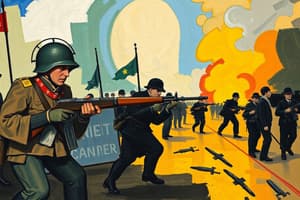Podcast
Questions and Answers
What was a similarity between WWI and WWII regarding preparedness?
What was a similarity between WWI and WWII regarding preparedness?
- Wilson did not support military budgets
- Only Roosevelt called for an arms buildup
- Congress did not increase military spending
- Both called for an arms buildup and neutrality at the same time (correct)
Which arguments were made for isolationism in WWI and WWII?
Which arguments were made for isolationism in WWI and WWII?
- Getting involved in European conflicts
- Focusing on fixing the Great Depression
- Both A and B (correct)
- None of the above
What was a key event that brought the U.S. into WWII?
What was a key event that brought the U.S. into WWII?
Pearl Harbor
Match the following groups with their experiences in WWI and WWII:
Match the following groups with their experiences in WWI and WWII:
How did financing the war differ between WWI and WWII?
How did financing the war differ between WWI and WWII?
What was the purpose of the League of Nations?
What was the purpose of the League of Nations?
The Four Freedoms were proposed by President Wilson.
The Four Freedoms were proposed by President Wilson.
What were the Four Freedoms?
What were the Four Freedoms?
The ______ program provided jobs for Mexican Americans during WWII.
The ______ program provided jobs for Mexican Americans during WWII.
Flashcards are hidden until you start studying
Study Notes
Preparedness: WWI vs. WWII
- Both President Wilson and President Roosevelt advocated for an arms buildup while promoting neutrality.
- Congressional military and naval spending increased by two-thirds during this period.
Isolation and Neutrality: WWI vs. WWII
- WWI isolationism was fueled by nearly a century of detachment from European conflicts.
- WWII arguments for isolationism emphasized domestic focus on economic recovery from the Great Depression.
- Both conflicts saw the U.S. enter the war late, reflecting a desire to avoid military engagement.
Pearl Harbor / Resumption of Unrestricted Submarine Warfare
- The Pearl Harbor attack was an unexpected event that drew the U.S. into WWII.
- Unrestricted submarine warfare was a prior military strategy, not solely targeting Americans.
- Both events aimed at destabilizing military power, leading to U.S. involvement in their respective wars.
African Americans in WWI vs. WWII
- WWI provided job opportunities for African Americans during the Great Migration as men left for war.
- In WWII, they participated in the air corps and gained recognition despite being segregated.
- Discrimination persisted for African Americans in both conflicts.
Mexican Americans in WWI vs. WWII
- In WWI, language barriers led to Mexican Americans being segregated in military ranks as the government initially engaged with Latino populations.
- WWII saw increased employment opportunities through programs like "bracero."
- Discrimination was a common experience for Mexican Americans in both wars, despite government support.
German Americans in WWI vs. Japanese Americans in WWII
- WWI saw negative propaganda against German Americans, undermining their cultural identity in the U.S.
- Japanese Americans faced internment, losing homes and businesses, and experiencing severe discrimination during WWII.
- Both groups faced significant discrimination during their respective wars.
Financing the War: WWI vs. WWII
- WWI financing relied on the sale of war bonds and the expectation of European repayment via the Dawes Plan.
- WWII utilized similar methods by both selling war bonds and raising taxes to fund the war effort.
- Both wars hinged on the sale of war bonds as a crucial funding mechanism.
Office of War Information vs. Committee on Public Information (CPI)
- The WWII Office of War Information was created to foster patriotism and unity among Americans.
- The CPI during WWI promoted public support through propaganda, educating about democracy and national unity.
- Both agencies aimed to bolster support for the war efforts and instill patriotism among citizens.
Women in War: WWI vs. WWII
- In WWI, women filled jobs traditionally held by men, exploring newfound freedoms in the 1920s.
- WWII also saw women entering the workforce, though many returned to traditional roles post-conflict.
- A shared experience was the significant increase of women taking over jobs during both wars.
Organized Labor: WWI vs. WWII
- WWI involved citizens participating in victory gardens to support troops and the government directing factories for war supplies.
- WWII resulted in job creation and government oversight of war production through a dedicated war production board.
- Both conflicts emphasized job creation and increased government involvement in industry.
League of Nations
- Proposed by Wilson in 1919, the League was part of his 14 points aimed at ensuring lasting peace.
- Envisioned as a global assembly with representation for all nations, the U.S. ultimately did not join.
- Concerns about self-determination and Congress's war-declaring power influenced non-participation.
14 Points
- A set of principles outlined by President Wilson in 1918 intended to promote global peace.
- Key points included self-determination, freedom of the seas, free trade, reduction of arms, and establishment of a league of nations.
Four Freedoms
- Articulated by President Franklin D. Roosevelt in 1941, emphasizing fundamental human rights.
- Proposed four freedoms: speech, worship, from want, and from fear as essential principles for democracy and peace.
Studying That Suits You
Use AI to generate personalized quizzes and flashcards to suit your learning preferences.




